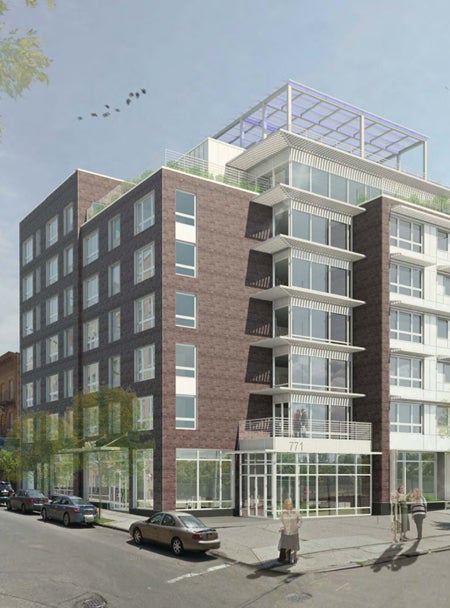
Crotona Senior Residences, Bronx, New York / Rendering by architectural firm of record: Magnusson Architecture and Planning PC, via Welcome to the Bronx
Senior living communities can either be car-dependent and isolated, or an urban or suburban “destination for experiences,” with proximity to transportation, services, arts and culture, restaurants, shopping, and personal development opportunities. Which community would you want to live in? The answer was clear in a session at Environments for Aging in Las Vegas.
According to Michael Hass, managing partner, Drive Development Partners, who is also a member of the Urban Land Institute’s senior housing council, from 1990-2009, senior living communities, mostly geared towards the World War I-era “silent” generation, were all about providing “a sense of security, peace of mind, ‘safety in numbers,’ and belonging.”
But in 2009, occupancy across the senior living industry dropped. This was a key year, the first year baby boomers (those born between 1946 and 1964) became consumers of these places themselves, not just shoppers of these facilities for their parents. Their views on the traditional places could be summed up with: “I’ll never live in a place like that.”
Starting in 2009, senior living developers saw new demand among some of the oldest baby boomers for communities with “flexibility, choice, a unique variety of experiences, and spending opportunities.” They don’t want the self-contained campus, “35 acres in a cornfield.” Hass said: “They want an individualized experience, not the same formal dining room every day.”
Sean Thomson, senior living director, CR Architects, said a new model is needed to reach the 75-million-strong boomers, and walkable urban communities could be it. Walkable urbanism is in demand among all age groups, but is particularly appropriate for seniors.
A report from the George Washington University school of business found that “walkable urbanism is gaining market share.” Furthermore, there is a 90 percent premium for walkable office space, 71 percent premium for retail, and 66 percent premium for multi-family housing.
A 2013 report from Fannie Mae found senior communities with a WalkScore above 80, which means they are walkable, had a “relative risk of default that is 60 percent lower.” Those communities with a WalkScore below 8, which deemed them totally car-dependent, had a “risk 121 percent higher.” As Thomson explained, “walkable communities have a real human impact, but they also have real financial results.” Places with WalkScores in the 60 and 70s have some services in walking distance, but those with scores of 90-plus are ideal.
The ideal walkable senior community is basically found in dense European and Asian cities, or New York City. Imagine an apartment complex in a highly walkable environment, open to the surrounding neighborhood, with ground floor shops, cafes, and restaurants, and close to multi-modal transit opportunities, parks, plazas, self-storage facilities, and co-working spaces. Instead of all these services provided within an isolated campus, they are distributed through the surrounding neighborhood.
Thomson said an urban environment can provide better quality and a higher range of restaurants than any isolated senior community can. Embedding a senior community in a neighborhood also enables that inter-generational contact, social integration, and intellectual engagement so critical to “successful aging.”
Thomson summed up the benefits of walkable urbanism for seniors: “you don’t have to build the amenities; they are already there.”
To make these kinds of communities happen will take some creative housing development strategies. Senior housing developers can partner with medical groups, physicians networks, hospital districts, religious institutions, fitness or wellness companies, or become parts of existing mixed-use developments. “Senior living developers are almost never the top bidders so they need to be part of mixed-use projects, attach themselves to bigger projects.”
In revitalizing second-tier cities, senior housing developers have a real chance, particularly if they piggy-back on mixed-use developments where it’s advantageous to have a set of new fixed-income resident buyers all in one place. “Senior living communities can become an asset to a community.”
Senior housing developers can remake under-performing hotels or extended-stay hotels, or B and C class multi-family housing. “They can partner instead of acquire.”
Also, Thomson can even see universities and colleges building nearby housing for retired alumni who want to return to the area.
They created a vision of a 2.5-acre urban senior development with medical facilities, spa, club, street-facing “fast, fresh” restaurants, shops, a playground, grocery store, and housing for 100-200 residents. “It wouldn’t be adult daycare, but a place where people enjoy themselves.” Perhaps this model could be deemed senior or grey urbanism?
When asked where this comprehensive vision is actually happening in the U.S., both Thomson and Haas said “some elements are happening incrementally, but not all together.”
